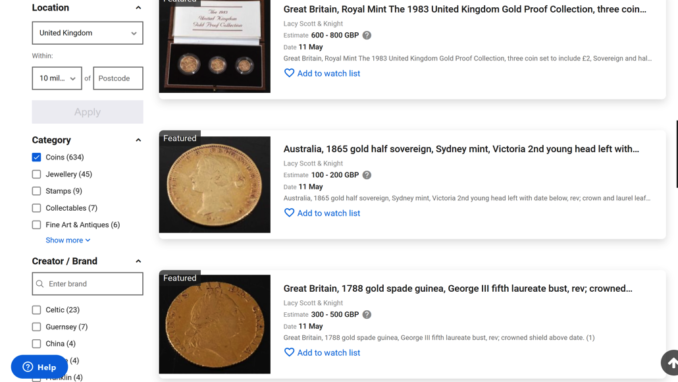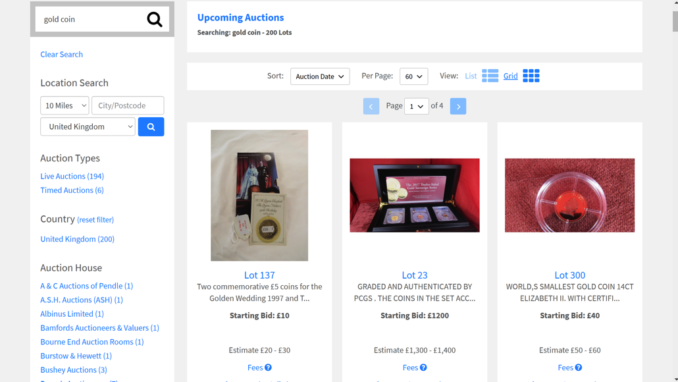Prior to becoming interested in precious metals I had never visited the inside of an auction house, let alone placed a bid. However, during the last lockdown I discovered that auctions can be a rich source of acquiring gold and silver and this can be done from the comfort of your own chair. Here is a quick guide to buying at auction – for anything, not just precious metals.
How to search for items for sale
During my own research I came across two websites which act as aggregators on behalf of a number of auction houses across the UK. I haven’t been able to establish how many auction houses they represent between them, but it’s enough to make them a worthwhile source to start with.
The first aggregator site I learned of is ‘the saleroom’ (https://www.the-saleroom.com/en-gb) which seems to be the largest of its kind in the UK. It has a pretty good search engine which allows you to enter a search term and then apply filters to narrow down the list of results. For example, you can search for “gold coin” and further narrow it down to auctions taking place within a 10-mile radius of your postcode.
Once you’ve created a list of items of interest you can add them to your ‘watch list’ so you can keep an eye on them.

The site is free to join and there is no cost to search for items, however when you bid on an item there is typically (but not always) an additional fee added to items you win, which is on top of the auction house fees. The additional fee is in the region of 4.95% of the sale price. All fees are clearly explained in each lot you are bidding on. Auction house fees seem to range from 18% to 28%, from the lots I’ve bid on. These will be plus VAT too – just on the auction fee, not the winning bid price.
In order to place a bid you first have to get yourself approved by the auction house. This is simply a case of clicking on the “Register to Bid Online” button and approval is instant in most cases. Once you’ve been approved you can place a bid. This can be done before the auction has started, or whilst it is live, on the day of the auction. If you are bidding on an item as it is being sold you will see if you are the leading bid or whether you have been outbid. You get plenty of time to increase your bid, which goes up in fixed amounts depending on what the current leading bid is. Sometimes the auctioneer will allow smaller increments if they feel someone will bid a bit more but not as much as the next increment.
Whilst the auction is live, you will be able to join the auction and hear (and in many cases see) the auctioneer describing the lots and encouraging higher bids.
Any lots you’ve successfully won will appear in the “My Saleroom” section of your account. An invoice will be emailed to you once the auction is complete (the same day or the following day) with instructions on how to pay. Most auctions allow you to pay by debit card or bank transfer and you typically get 3 to 5 days to settle any amounts owed.
It is worth checking to see whether the auction house will arrange postage and packaging for you. It is easy to find this from both The Saleroom and Easy Live platforms. Many auction houses offer a P&P service at reasonable prices or they will outsource it to a third party such as Mailboxes etc, who will arrange for the item to be packaged and delivered on your behalf. For smaller items such as coins this isn’t a problem but larger items such as furniture can be awkward to deliver and these would probably be better picked up by your own means. The value of the items can affect postage costs too as insurance needs to be taken out to cover the cost of the item should it go missing or get damaged in transit.
The second aggregator site I have used is ‘Easy Live’ (https://www.easyliveauction.com/). This too is free to join and use to search for items. The search engine on Easy Live isn’t as comprehensive as The Saleroom (for example, with The Saleroom you can select a category of ‘coins’, but no such facility exists on the Easy Live platform that I can see). However, the additional fees applied by Easy Live can be significantly lower than The Saleroom. Most auctions Easy Live feature give you the option of paying a fixed fee (typically £3.00 per auction) with no other fees being applied to any lots you win. Other than this, the process of getting approval and bidding is much the same as The Saleroom.

Top Tips
Many auctions are covered by both The Saleroom and Easy Live, so it’s a good idea to check this and use the site with the lowest fees.
Most auction houses allow you to bid via their own bespoke online platforms thereby avoiding the fees applied by The Saleroom and Easy Live. I often find an item of interest using the aggregator sites and then look on the auction house site to see if I can register and bid via their own platform, which works out the cheapest.
It sounds obvious, but set yourself a limit and stick to it. It’s very easy to keep upping your bid on an item you really want, to the point you spend far more than you intended to.
Most lots will have multiple pictures of the items on sale. Make sure you study the pictures in great detail – zoom in on areas of interest and check for damage or marks etc. Do this several times, it’s amazing how you miss things on the first and second viewings.
Finally, a warning. Bidding can be addictive!
I hope this mini-guide has been useful and wish you good luck if you decide to start bidding.
The Goodnight Vienna Audio file



